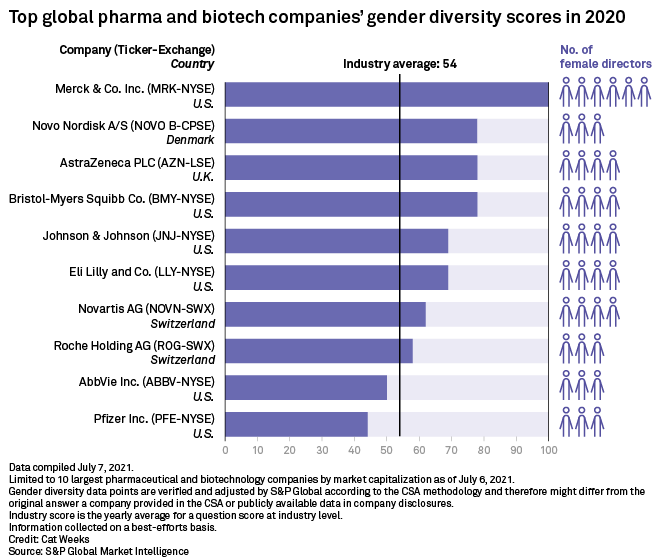S&P Global Offerings
Featured Topics
Featured Products
Events
S&P Global Offerings
Featured Topics
Featured Products
Events
S&P Global Offerings
Featured Topics
Featured Products
Events
Banking & Capital Markets
Economy & Finance
Energy Transition & Sustainability
Technology & Innovation
Podcasts & Newsletters
Banking & Capital Markets
Economy & Finance
Energy Transition & Sustainability
Technology & Innovation
Podcasts & Newsletters
S&P Global Offerings
Featured Topics
Featured Products
Events
13 Jul, 2021
By Michael Gibney

While women represent 47% of the workforce overall, they account for 26% of science, technology, engineering and math roles, according to the Pharmaceutical Research and Manufacturers of America.
Source: SolStock/E+ via Getty Images
Biopharmaceutical companies are setting themselves increasingly ambitious goals to ensure greater representation for women and minority communities, analyzing employee data to produce a more diverse pipeline of talent.
Black and Hispanic employees make up about 13% and 18% of the pharmaceutical workforce, respectively. However, these groups only account for 8% and 9% of science, technology, engineering and mathematics — known as STEM — occupations within the sector, according to Lori Reilly, COO of the Pharmaceutical Research and Manufacturers of America, the trade group known as PhRMA.
And while women represent 47% of the workforce, they account for only 26% of STEM roles, Reilly told S&P Global Market Intelligence.

Pharmaceutical companies have begun to devote more resources to increasing diversity by supporting employee resource groups, providing professional development opportunities, promoting leadership for underrepresented groups, diversifying the STEM talent pipeline and incentivizing suppliers led by people of color, PhRMA noted in a December 2020 report.
"A lot of companies have really put an even greater concerted effort into saying, 'If our goal is to have greater representation and greater diversity in our leadership ranks, then we need to start earlier so that we're building a pipeline,'" Reilly said. "As those students age through the process, they become interested in the kinds of opportunities that might exist in the pharmaceutical field."
This push for greater diversity reflects a cross-sector trend — 45% of new board seats at Russell 3000 companies were filled by women in 2019 compared to just 12% in 2008, according to a 2019 Harvard Law School Forum on Corporate Governance report. Ethnic diversity on companies' boards also grew, albeit at a slower pace, with about 15% of new board seats filled by an individual from a minority group in 2019 compared to 8% in 2008.
A business imperative
When it comes to the representation of women throughout businesses, the pharmaceutical and biotechnology sectors hold an average S&P Global gender diversity score — calculated from companies' responses to a questionnaire on environmental, social and governance — of 54. In comparison, the banking sector has a score of 51.
|
Johnson & Johnson Chief Diversity & Inclusion Officer Wanda Hope Source: J&J |
Johnson & Johnson began reporting on this topic in 2019. The first review showed that while the proportion of full-time employees who were women had been rising in recent years, they held only 14% of executive roles and 29% of seats on the board of directors.
By the time of J&J's 2020 annual report, those numbers had risen to 27% and 36%, respectively.
The company has committed to 50% of management positions being held by women by 2025, J&J's Chief Diversity, Equity and Inclusion Officer Wanda Hope told S&P Global Market Intelligence. Additionally, J&J is aiming to reach 35% racial and ethnic diversity and 50% growth in Black leadership across its management positions by the same year.
"We approach diversity, equity and inclusion as a business imperative," Hope said. "We use data and insights to drive accountability and deliver on business outcomes [and] we know that by bringing together people with different perspectives, backgrounds and experiences, we fuel our creativity, innovation and growth."
J&J ranked 40th in a list of the 100 most diverse and inclusive companies across sectors compiled by financial data analytics platform Refinitiv in
A broader trend
Pfizer Inc., which did not feature on Refinitiv's list, began reporting social performance metrics in its 2020 annual report. CEO Albert Bourla said in the report that the company has "set concrete goals to address systemic racism and gender equity challenges by reviewing and augmenting our plans to increase diversity and opportunity parity by 2025."
Pfizer aims to reach 47% representation of women at the vice president level and above by 2025, up from 38% in 2020. The company also committed to increasing minority representation at the vice president level from 19% to 32% in the same timeframe.

Genentech Inc. — a U.S.-based subsidiary of Swiss pharma giant Roche — has set its own diversity goals out to 2025. The program has worked for the company in the past, Genentech Chief Diversity Officer Quita Highsmith told S&P Global Market Intelligence, and the goals have been updated to reflect new discoveries in their data, including Black, Asian and Hispanic representation at management levels.
Women represented just 16% of Genentech's officer-level employees in 2010, but that number has risen to 43% after employee opinion surveys and a specially commissioned study provided management with a clearer picture of women's experiences and barriers to advancement at the company.
"We've had a multi-pronged approach with a long-term strategy, where we were able to elevate and increase the voice of women in leadership — but that took 10 years," Highsmith said. "We've learned a lot along the way, so we believe that we should take those lessons learned and elevate our aspiration around increasing people of color."
To this end, Genentech has committed to doubling Black and Hispanic representation among directors, officers and extended leadership, as well as match Asian leadership roles to reflect representation across the company's workforce. Genentech is also investing in future leaders with the launch in 2020 of a two-year policy fellowship at Howard University, a historically Black research university, in partnership with the U.S. Food and Drug Administration. Genentech has also pledged $10.5 million over five years to support underrepresented post-secondary students at San Francisco State University.
|
Genentech Chief Diversity Officer Quita Highsmith |
"For me as a Black woman in the biotech industry, I was and still am particularly concerned about how COVID-19 is amplifying health disparities in communities of color," Highsmith said. "Who's getting the vaccine, who's still getting hit by COVID — and I think it has opened up a lot of people's eyes."
Diversity in leadership can help companies to address problems such as a lack of minority representation in clinical trials, Highsmith added. "We're talking about ensuring that we've got employees and patients from underrepresented groups so that people can trust the research."
Looking to outside suppliers
Another of Genentech's new goals is to devote $1 billion to partners who are considered diverse suppliers, defined by Genentech as companies with employment of more than 50% of people who are Black, Hispanic, disabled, LGTBQ,
Bristol Myers has also committed to spending $1 billion by 2025 with Black and diverse-owned businesses, according to the company's annual report. Like Genentech, the company is aiming to double Black and Hispanic representation at the executive level. And J&J is aiming to spend $4.5 billion with suppliers considered small and diverse, which would be a 20% increase from 2020 spending.
"We've acknowledged the importance of ensuring that our workforce actually better reflects the patients and the communities we serve because it's important for the future competitiveness of the industry, and also in terms of building trust with the patients that we serve," PhRMA's Reilly said. "And there's still opportunity for improvement."
